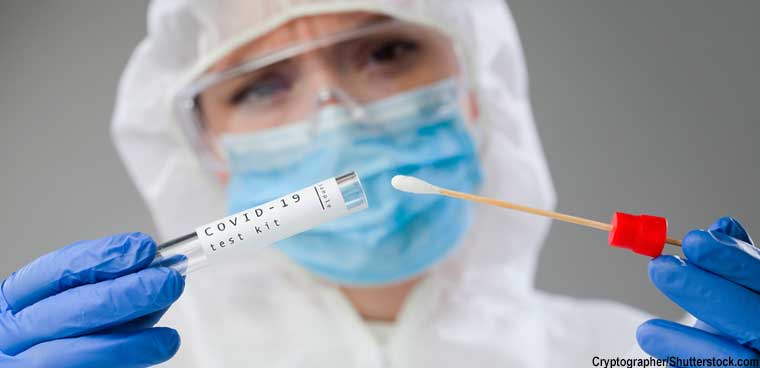Researchers from the University of California, Berkeley, think even more people can be tested by combining pooling with machine learning tools that estimate the risk of COVID for each person to be tested.
copyright by gcn.com
 On June 18, the Food and Drug Administration authorized the use of pooled testing for identifying COVID-19 infections. The method allows up to four swabs to be tested at once – a strategy that is expected to greatly expand frequent testing to larger sections of the population.
On June 18, the Food and Drug Administration authorized the use of pooled testing for identifying COVID-19 infections. The method allows up to four swabs to be tested at once – a strategy that is expected to greatly expand frequent testing to larger sections of the population.
The idea is that if a bundled sample comes back positive, then all the individuals in that sample will need to be tested separately. If a bundled sample comes back clean, however, that’s four people who don’t need to be tested further, saving public health officials time and money.
The FDA said it expects pooling will allow virus identification with fewer tests, which means more tests could be run at once, fewer testing supplies would be consumed and patients could likely receive results more quickly. The pooling strategy will be most efficient in areas where the outbreak is under control, meaning where only a small percentage of test subjects are expected to be infected, the FDA acknowledged.
Researchers from the University of California, Berkeley, think even more people can be tested by combining pooling with machine learning tools that estimate the risk of COVID for each person to be tested, according to an article they authored in MIT Technology Review.
“Take, for example, data on the home zip code of an individual,” the researchers said in their research paper. “While zip code alone is certainly informative, interactions with other observable factors such as age, travel or consumption patterns are likely to improve model performance in terms of prediction for day-specific risk (e.g. living in a location with high prevalence increases ones risk but more so if a person frequently eats out and socializes and even more so if they did so in the last two days).”
“Using publicly available data from employers and schools, epidemiological data on local infection and testing rates, and more sophisticated data on travel patterns, social contacts, or sewage, if available, modelers can predict anyone’s risk of having COVID-19 on a day-by-day basis,” the researchers wrote in MIT Technology Review.
With that information in hand, public health officials could test pools of optimal individuals, winnowing out likely carriers of the virus based on location, demographics, age, job type, living situation, along with past infection data. Conducting pooled testing on those with low risk of infection will therefore greatly expand the speed and efficiency of testing. […]
Thank you for reading this post, don't forget to subscribe to our AI NAVIGATOR!
read more – gcn.com


Researchers from the University of California, Berkeley, think even more people can be tested by combining pooling with machine learning tools that estimate the risk of COVID for each person to be tested.
copyright by gcn.com
The idea is that if a bundled sample comes back positive, then all the individuals in that sample will need to be tested separately. If a bundled sample comes back clean, however, that’s four people who don’t need to be tested further, saving public health officials time and money.
The FDA said it expects pooling will allow virus identification with fewer tests, which means more tests could be run at once, fewer testing supplies would be consumed and patients could likely receive results more quickly. The pooling strategy will be most efficient in areas where the outbreak is under control, meaning where only a small percentage of test subjects are expected to be infected, the FDA acknowledged.
Researchers from the University of California, Berkeley, think even more people can be tested by combining pooling with machine learning tools that estimate the risk of COVID for each person to be tested, according to an article they authored in MIT Technology Review.
“Take, for example, data on the home zip code of an individual,” the researchers said in their research paper. “While zip code alone is certainly informative, interactions with other observable factors such as age, travel or consumption patterns are likely to improve model performance in terms of prediction for day-specific risk (e.g. living in a location with high prevalence increases ones risk but more so if a person frequently eats out and socializes and even more so if they did so in the last two days).”
“Using publicly available data from employers and schools, epidemiological data on local infection and testing rates, and more sophisticated data on travel patterns, social contacts, or sewage, if available, modelers can predict anyone’s risk of having COVID-19 on a day-by-day basis,” the researchers wrote in MIT Technology Review.
With that information in hand, public health officials could test pools of optimal individuals, winnowing out likely carriers of the virus based on location, demographics, age, job type, living situation, along with past infection data. Conducting pooled testing on those with low risk of infection will therefore greatly expand the speed and efficiency of testing. […]
Thank you for reading this post, don't forget to subscribe to our AI NAVIGATOR!
read more – gcn.com
Share this: